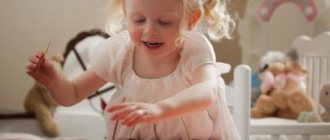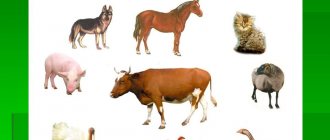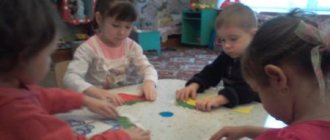Summary of a lesson on cognitive development on the topic: Pets. Junior group
Summary of a lesson on cognitive development in the junior group of the kindergarten “Friendly Hosts”
Author: Kameneva Elena Ivanovna Description of the material: Methodological development is intended for educators working with children of primary and secondary preschool age Purpose: To consolidate ideas about domestic animals. Objectives: Expand and deepen children’s understanding of domestic animals and their cubs;
to fix the external signs of animals, what they eat, how they voice, where they live, what benefits they bring. Develop coherent speech, improve the grammatical structure of speech; consolidate the formation of nouns with diminutive suffixes. Foster love and care for pets. Progress of the lesson
Educator: Do you guys like to visit?
Today we will also go to visit. I suggest you go visit our friends. And so that you find out where we are going to visit, I suggest you guess the riddles. Puzzles. 1. I live under the porch, I have a tail like a ring, I am friends with a person, I look after the house. (Dog.) 2. Who, walking on a leash, nibbles the grass on the hill, And, waiting for the mistress, Lonely bleats: “Me-e-e”? (goat) 3. Who grazes on the lawn, Without a panama hat and without a T-shirt, Drives away harmful flies, And moans protractedly: “Moo-oo” (cow) 4. The nose is a round snout, And the perky tail is a hook. Mom is a pig, dad is a pig. He is their favorite son. (Piglet) 5. I clatter my hooves, I clatter, I gallop, I gallop. The mane curls in the wind. Who is this? (Horse.) 6. Long ear, A ball of fluff. Jumps deftly, gnaws carrots. (Rabbit) 7. With a beard, not a man, With horns, not a bull. (Goat) 8. Shaggy paws, Scratches on paws. (Cat.) Educator: Well done, guys, you completed the task. Can you guess what animals we're talking about? (Children’s answers.) Educator: That’s right about pets, but why are they pets? (Children’s answers.) Educator: Everyone loves affection and animals too, let’s call them affectionately so that they feel pleasant.” Speech game with the ball “Call it kindly.”
Educator: Each of you has a cat at home. She is a very affectionate animal. When you pet her, she loves to purr. And now you and I will turn into cats. Turn around and turn into a cat!” Coordination of speech with the “Cat” movement. You know me closely. I'm a friendly pussy. At the top are the tassels on the ears, the claws are hidden in the pillows. In the dark I see vigilantly, I will not offend in vain. But teasing me is dangerous - I scratch terribly. They walk in a circle on their toes, sneaking, holding their arms bent in front of their chest. They stop, stand facing in a circle, make “ears” from their palms, then “claws” from their fingers. They walk in a circle again, stealthily. They stop again, stand facing in a circle and show their “claws”
Educator: All animals speak their own language. Let's remember who makes what sounds. Game “Who says what?” Who ate my stew? The pig grunts...(oink-oink) How does the pig talk? What is she doing? (“oink” - grunts) Give me some fresh grass! - The goat is bleating... (me-me) How does the goat talk? What is she doing? (“meh” - bleats) They didn’t pour enough milk! The cat meowed... (meow-meow). How does a cat talk? What is she doing? (“meow” - meows) Grab the thief by the sleeve, The dog barked... (woof-woof-woof). How does the dog talk? What is he doing? (“woof-woof” - barks) My master is far away! The horse neighs...(yoke) How does the horse talk? What is she doing? (“E-go-go” - neighs) I don’t understand where the calf is? A cow moos...(moo-oo) How does a cow talk? What is she doing? (“mu” - hums) Educator: Here are the pets on my table. We'll play with them. Game "Who is missing".
Educator: Domestic animals have cubs. Let's play the Baby Pets game and remember them. Game "Baby Pets". The father is a bull, the mother is a cow, the child is a calf. Dad is a goat, mom is a goat, baby is a goat. Dad is a horse, mom is a horse, baby is a foal. Dad is a dog, mom is a dog, baby is a puppy. Father-cat, mother-cat, child-kitten. Dad is a ram, mom is a sheep, baby is a lamb. Dad is a boar, mom is a pig, baby is a pig.
Educator: Now let’s turn around ourselves and turn into rabbits. Physical school Rabbit stretched once, twice, three, four, five times, bent over, twice, bent down, spread his paws to the side, but couldn’t find the carrots. To get the carrots, we need to stand on our tiptoes.
Educator: Guys, animals need to be fed, so let's give them a treat. Game "Feed the Animals". What will you treat the cow? (I will treat the cow with hay.) What will you treat the dog? (I will treat the dog with a bone and meat.) What will you treat the horse with? (I will treat the horse with grass.) What will you treat the cat with (I will treat the cat with fish and milk.) What will you treat the goat with (I will treat the goat with hay.) What will you treat the rabbit with? (I will treat the rabbit with a carrot.) What will you treat the pig? (I will treat the pig with bread) What will you treat the cat? (I'll treat the cat to fish). Educator : And now the most difficult task for you. You need to collect a picture of a pet and name it. Collective task “Cut picture”.
Educator : Well done! Everyone completed the task. Let's think again about what we call pets. We will classify as domestic animals those with whom we live in close contact; Cows and horses, Sheep and goats We shelter them in warmth from the frost. We feed and water them, if they need a haircut, we pet them affectionately, we always take care of them. They are attached to us, very obedient and not indifferent to our voice. Some give us milk and sour cream. Others take us everywhere tirelessly.
We recommend watching:
Summary of GCD in the junior group “How to take care of your teeth?” A lesson on describing toys in the junior group of a kindergarten. Summary of a lesson on cognitive development in a junior group on the topic “Pets and their children. Summary of a lesson on cognitive development in the second junior group using ICT “Travel”
Similar articles:
Synopsis of a physical education lesson in the junior group “Spring Puddles”
Summary of a lesson on speech development and modeling in junior group 1
Summary of educational activities on cognitive and speech development in the 1st junior group
Summary of a lesson on health conservation for the second junior group
Summary of an art lesson in junior group 1
LiveInternetLiveInternet
Quote from Tatyana57
Read in full In your quotation book or community!
SPEECH DEVELOPMENT. LEXICAL TOPIC “PETS AND THEIR CHILDREN”
CHILDREN SHOULD KNOW THE NOUNS: cat, cat, kitten, dog, dog, puppy, cow, bull, calf, horse, horse, foal, pig, hog, piglet, goat, goat, kid, sheep, ram, lamb, rabbit, rabbit , baby rabbit, herd, herd, pigsty, shepherd, milkmaid, pig farm, horns, hooves, tail, mane, fur - wool, stubble, bone, paws, farm, collective farm, udder, nostrils, stable, can, collective farmer (tsa), oats, swill, hay, muzzle, head, mouth, claws, hooves, ears, jaw, leather, saddle, bridle, whip, cart, kennel, pasture, rabbitry, groom, bangs, snout, nickel, animals ADJECTIVES: short, long , soft, fluffy, gray, red, smooth, shaggy, hard, thick, curly, domestic, smooth-haired, guard, sanitary, border, fire, circus, affectionate, kind, mustachioed, clumsy, strong, fast, weak, long-eared, faithful , funny, amusing, spotty. VERBS: meows, moos, barks, grunts, neighs, chews, bleats, gnaws, purrs, laps, grazes, eats, digs, harnesses, gnaws, kicks, runs, butts, feed, care for, jumps, carries, gives milk, catches , guards, guards, prances, jumps, licks, tugs, plays, makes friends. CHILDREN SHOULD BE ABLE TO FIND CHILDREN AND THEIR PARENTS AND VICE VICE: A cat has a kitten, a dog has a puppy, a goat has a kid...
SELECT SIGNS: Puppy - small, long-eared, funny, stupid, funny.. Calf - ..., Cat - ..., Rabbit - ... DESCRIBE ANIMALS ACCORDING TO PLAN: Name. Appearance. What does it eat? Where he lives. How he gives his voice. What benefits does it bring? Tell the children what benefits pets bring: - a dog and a dog guard the house; — a cat and a cat catch mice; - a cow gives milk and meat, but a bull only gives meat; - horse, horse, donkey, donkey, camel and she-camel, transport goods or people on horseback; - pig and boar provide meat and stubble; - sheep and ram - wool and meat; - a rabbit and a female rabbit give fur; - a goat gives wool, a goat gives wool and milk. Talk with the children about what they feed domestic animals, what kind of housing they live in, who the groom, pig farmer, milkmaid, and cattleman take care of. COMPARE TWO ANIMALS ACCORDING TO PLAN: What body? What is it covered with? What ears, nose, eyes, tail, muzzle...? What do they eat? Where live?Game: “Tell me which one?” (Adjectives describing appearance). Big, small, fluffy, spotted, purebred, large, Game: “Name the habits” (Adjectives characterizing the habits of an animal). Nimble, fast, slow, clumsy, agile, playful, brave, Game: “Say the opposite” (selection of antonyms) Big - small, thick - thin, long - short. Game: “How does it move?” (Activation of the verb dictionary) Jumps, runs, caresses, walks, wanders, runs, stretches. Game: “One - many (Formation of plural nouns from singular) Dog - dogs, puppy - puppies, poodle - poodles, shepherd - shepherds. Game: “Count” (Agreeing numerals with nouns in gender and number) One dog, two dogs, three dogs, four dogs, five dogs, etc. Game: “Whose, Whose, Whose?” (Possessive adjectives) The muzzle of (whose?) a dog, the paws of (whose?) a dog, the tail of (whose?) a dog, etc. Game: “Complex words” Long hair is long-haired, a short tail is short-tailed, droopy ears are lop-eared. DOGS AND THEIR PURPOSE. The Poodle is a circus dog: easy to train and seemingly endlessly ready to perform funny tricks. Poodles are also excellent swimmers. The Scottish Scotch Terrier is a guard dog: you should not mistake it for a small, harmless dog. He has a well-developed guard instinct. The dachshund is a hunting dog, capable, due to its size and body structure, of getting into holes. The shepherd is a guard, guards criminals, serves on the border. Collie is a guide dog that helps the blind cross the street, get to the store, etc. Bobtail is a sheep guard, guarding flocks of sheep. Laika is a sled dog that carries people on sleds. RETELLING OF L.N. TOLSTOY'S STORY “FIRE DOGS” Sleeps under the porch, Tail like a ring, Barks, bites, Doesn’t let him into the house (the dog). A dog can be a sled dog, a circus dog, a service dog, a guard dog, a guard dog, a guide dog, etc. Let's learn about another appointment of our most faithful assistants. It often happens that in cities during fires, children remain in houses and cannot be pulled out, because they hide and are silent from fear, and from the smoke they cannot be seen. Dogs in London are trained for this purpose. These dogs live with firefighters, and when a house catches fire, the firefighters send the dogs to pull the children out. One such dog saved twelve children. READING A STORY. We read L. N. Tolstoy’s story “Fire Dogs”, sequentially setting the appropriate reference signals. One time the house caught fire. Firefighters arrived at the house with a dog named Bob. A woman ran out to them. She cried and said that there was a two-year-old girl left in the house. The firefighters sent Bob. Bob ran up the stairs and disappeared into the smoke. Five minutes later he ran out of the house, carrying the girl by the shirt in his teeth. The mother rushed to her daughter and cried with joy that her daughter was alive. The firefighters caressed the dog and examined it to see if it was burned; but Bob was eager to get into the house. The firefighters thought there was still something alive in the house and let him in. The dog ran into the house and soon ran out with something in its teeth. When the people looked at what she brought out, they all burst out laughing: she was carrying the girl’s favorite doll. ANALYSIS OF THE CONTENT OF THE STORY. — Did you like the story, why exactly? We ask detailed questions about the text, seeking the most complete and accurate answer, as well as the correct construction of sentences: - What happened once? (The house caught fire once) - Who did the firefighters come to the house with? (Firefighters arrived at the house with a dog named Bob) - Who ran out to the firefighters when they arrived? (A woman ran out to them) - What did the woman do, what did she talk about? (She cried and said that there was a two-year-old girl left in the house) - How did Bob carry the girl? (he was carrying the girl by the shirt in his teeth). — What did the girl’s mother do? (The mother rushed to her daughter and cried with joy that her daughter was alive) - What did the firefighters do after the dog carried the girl out? (The firefighters caressed the dog and examined it to see if it was burned) - Where was Bob going? (Bob was rushing into the house) - What did the firefighters think? (The firefighters thought that there was still something alive in the house and let him in) - When the people looked at what she had taken out, what did they do? (When the people looked at what she brought out, they all burst out laughing: she was carrying the girl’s favorite doll) RE-READING THE STORY. RETELLING.





